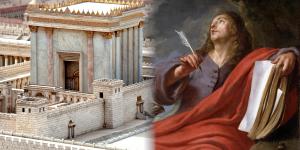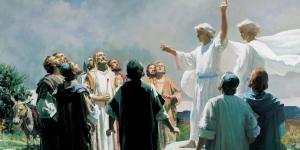You are here
What Is the Mystery of Faith?

1 Timothy 3:8–9
The Know
When Paul wrote his epistles to Timothy and Titus, he offered many instructions regarding the qualifications of those who were to be called to be local leaders and priesthood holders in the Church. Regarding the deacons, Paul instructed Timothy that in addition to being moral, they must hold “the mystery of the faith in a pure conscience” (1 Timothy 3:8–9).1
This faith, or pistis, was often used to describe a relationship of trust and faithfulness between God and mankind.2 Furthermore, while modern readers may see the term mystery and draw the conclusion that faith itself is mysterious or unknowable in nature, such was not the case in Paul’s ancient context or for his ancient readers. The Greek word mystērion, for instance, was best understood as a secret rite or teaching that was often connected to customs and ceremonies not to be revealed to the public.3 As such, many uses of mystērion appear to refer to ordinances or sacred counsel from God that is not to be disclosed to those not worthy of receiving them.
Similarly, the pistis relationship common throughout the ancient world could be formalized through ritual actions, and the mystery mentioned by Paul appears to be understood in this context.4 Indeed, Brent J. Schmidt has noted that pistis was additionally understood in Paul’s time to be “a covenant, oath, or guarantee that created trust, which was relied on to bring about assurance through sacred law.” In conjunction with this covenantal oath, pistis could also take the form of “signs given to the faithful who already trusted God.” These signs were given to act as evidence and lead the faithful saint to “greater knowledge and truth” and could further persuade “individuals, groups, and Hellenistic societies of the certainty of what they commonly experienced.”5
These oaths and signs ultimately found their place in the temple. This is especially true of the phrase “mystery of the faith” as used by Paul, which Schmidt has noted “meant ritual pledges, often anciently associated with revelation in temples” in the first century. Furthermore, “since pistis commonly meant ‘pledge’ or ‘assurance,’ it is very likely that pistis also meant ‘covenant’ for first-century Christians.” As such, mysteries of God, including the “mystery of the faith,” are best understood as something “revealed through Jesus and prophetic writings about his sacrifice and resurrection” that evokes obedience typical of a pistis covenant and could be formalized through a ritual action or ordinance.6
One of the mysteries for early Christians was the first ordinance required to enter the covenantal community: baptism. Schmidt has observed that early Christians “associated mysteries with religious rituals, such as baptism,” seeing faith and making covenants with God as enabling disciples “to understand the ‘mystery’ of his gospel.” Pistis was also closely linked to Christian ordinances by often involving ritual pledges that the initiates would say, such as a baptismal formula preserved in the Apostolic Constitutions that included renouncing the devil and promising to be faithful to God throughout their life.7 Other ordinances were likewise described in similar terms by early Christian writers.
If baptism and its ritual pledge was had in mind by Paul, then “in this ancient context, the deacons were being exhorted to hold fast to covenantal pledges of baptism, which were mysterious only to the outside world.”8 Regardless of whether or not this particular ordinance is being referred to, Paul is clearly informing Timothy that all deacons ordained must be true to the covenants they have made, holding them in “a pure conscience.” Having been initiated into the mystērion, or ordinances, of the gospel, they had to honor the sacred nature of what they had experienced.
Similar injunctions to hold fast to sacred teachings and ordinances and not reveal them to the uninitiated are likewise found throughout the scriptures. For example, Jesus told His disciples, “Give not that which is holy unto the dogs, neither cast ye your pearls before swine, lest they trample them under their feet, and turn again and rend you” (Matthew 7:6). Scholars, including John W. Welch, have observed that the holy thing mentioned in this verse is likely a piece of special, sacred knowledge, “something they are required to keep sacred and confidential—an implication consistent with some other interesting conclusions of Jeremias regarding the existence of sacred, secret teachings and practices in primitive Christianity.”9
The Book of Mormon begins with Nephi stating that he had “a great knowledge of … the mysteries of God,” which was apparently the basis on which Nephi made his record of “the more sacred things”—a record he began in connection with building a temple.10 Nephi’s record culminates with an injunction to “speak with the tongue of angels,” (2 Nephi 32:2), which “may represent breaching the veil to enter into the Lord’s presence, becoming divine, and thereby joining the divine council.”11 Like the mystery of the faith, this clearly reflected sacred ordinances or knowledge to be shared only in sacred spaces.
Ultimately, the pistis oaths, covenants, and ordinances bring strength and miracles to those who faithfully abide by them and hold them fast. As noted by Schmidt, “knowledge about and faith in one’s own divine nature, expressed through action, brought about miracles” to many people in the New Testament whom Jesus identified as being healed or able to heal others through the power of their faith.12 These surely included many who had performed ordinances and were true to the covenants they had made with the Lord.
The Why
As noted by Schmidt, “ancient nuances of faith (pistis) bring about blessings that lead to conversion, in contrast to sin that results in unhappiness.”13 These nuances, including oaths, covenants, and ordinances, are likewise essential today in our own conversion to the gospel.
As we read the New Testament, we find that faith is closely associated with actions meant to develop “a patron-client relationship with God, which is confirmed by trustworthiness, followed by a miracle.” Accessing the full powers of this relationship requires us to act, to make covenants, and to be faithful to them: “Once a faithful relationship is established,” Schmidt observes, “one merely needs to act, and great spiritual experiences will occur.”14
As we maintain our relationship with God, we will be driven to repent more fully and will seek to hold fast to the mysteries of the faith so that we, too, might be found worthy of the relationship we have made. These mysteries begin to be revealed to us at baptism as we enter the covenant path, and they continue as we progress through the temple ordinances and prepare to enter the presence of God again—truly the greatest miracle that we may one day experience.
Further Reading
Brent J. Schmidt, Relational Faith: The Transformation and Restoration of Pistis as Knowledge, Trust, Confidence, and Covenantal Faithfulness (Provo, UT: BYU Studies, 2022), 67–85.
Neal Rappleye, “‘With the Tongue of Angels’: Angelic Speech as a Form of Deification,” Interpreter: A Journal of Latter-day Saint Faith and Scholarship 21 (2016): 303–323.
- 1. The Greek word deacon literally means “servant.” As such, the designation used by Paul may not be describing the same office in the priesthood called by that name today. Regardless of whether the same office is intended, it should be noted that some qualifications for the ancient ordaining of deacons included marital status and how well they raised their children (see 1 Timothy 3:11–12). These qualifications are not required for deacons in The Church of Jesus Christ of Latter-day Saints and may be a timely necessity for Paul’s generation rather than a timeless principle for all.
- 2. See Book of Mormon Central, “How Did Paul Understand Faith? (Romans 9:30),” KnoWhy 684 (August 15, 2023).
- 3. See Frederick William Danker et al., A Greek-English Lexicon of the New Testament and Other Early Christian Literature, 4th ed. (Chicago, IL: University of Chicago Press, 2021), 586, s.v. “μυστήριον.”
- 4. For the use of faithfulness, or pistis, in a ritual right handclasp, see Book of Mormon Central, “How Are Faithfulness and Grace Connected to the Right Hand of Fellowship? (Galatians 2:9),” KnoWhy 690 (September 26, 2023).
- 5. Brent J. Schmidt, Relational Faith: The Transformation and Restoration ofPistis as Knowledge, Trust, Confidence, and Covenantal Faithfulness (Provo, UT: BYU Studies, 2022), 68, 73–74.
- 6. Schmidt, Relational Faith, 80–81.
- 7. See Schmidt, Relational Faith, 69–71, 81.
- 8. Schmidt, Relational Faith, 82.
- 9. John W. Welch, Illuminating the Sermon at the Temple and Sermon on the Mount(Provo, UT: Foundation for Ancient Research and Mormon Studies, 1999), 111. As Welch shows throughout his book, the Sermon on the Mount recorded in Matthew 5–7 is steeped in ancient temple tradition.
- 10. 1 Nephi 1:1; 19:5; 2 Nephi 5; Neal Rappleye, “‘With the Tongue of Angels’: Angelic Speech as a Form of Deification,” Interpreter: A Journal of Latter-day Saint Faith and Scholarship 21 (2016): 305–308.
- 11. Rappleye, “‘With the Tongue of Angels,’” 305. See also Book of Mormon Central, “What Is It to Speak with the Tongue of Angels? (2 Nephi 32:2),” KnoWhy 60 (March 23, 2016). Some early Christians, including Clement of Alexandria, connected speaking or singing with angels to the mysteries and ordinances of the gospel preparatory to seeing the face of God. See Clement of Alexandria, Exhortations to the Heathen, chapter 12.
- 12. Schmidt, Relational Faith, 83. See, for example, Matthew 9:20–22; 15:22, 28; 17:18–20.
- 13. Schmidt, Relational Faith, 85.
- 14. Schmidt, Relational Faith, 83.
KnoWhy Citation
Related KnoWhys
Subscribe
Get the latest updates on Book of Mormon topics and research for free





